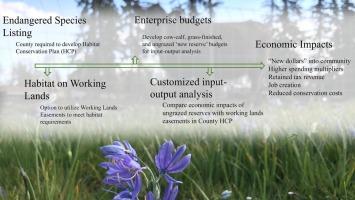Economic impacts of using working lands and prairie preserves for habitat protection: An example from Thurston County, Washington
IF 2.5
3区 环境科学与生态学
Q2 BIODIVERSITY CONSERVATION
引用次数: 0
Abstract
This study investigates the economic impacts of agricultural Working Lands Easements (WLE) and New Reserves (NR) in a Habitat Conservation Plan (HCP), and provides an example based in Thurston County, Washington. We analyzed the effect of varying levels of WLE inclusion in the County HCP, focusing on direct economic impacts, restoration costs, livestock production costs, tax revenue, and employment multipliers. The baseline assumption was that all funding for NR sectors would be locally sourced, displacing other local spending. Results show that scenarios with higher agricultural WLE inclusion generated significantly greater economic impacts, including higher direct economic impacts, tax revenue, and job creation, as compared to scenarios with minimal or no WLE involvement. When external funding for NR sectors was introduced at 15% and 25% levels, the economic impact of these sectors increased, suggesting the importance of securing non-local funding to enhance conservation efforts without adversely affecting the local economy. The study highlights the potential synergies of mandated habitat conservation and rural economic development, emphasizing the need for aspirational policy interventions that deliver economic benefits while achieving conservation goals. These findings provide insights for policymakers designing habitat conservation strategies that support both farm-based economic opportunity and environmental stewardship.

利用耕地和草原保护区保护栖息地的经济影响:以华盛顿州瑟斯顿县为例
本文以华盛顿州瑟斯顿县为例,研究了栖息地保护计划(HCP)中农业工作地地役权(WLE)和新保护区(NR)的经济影响。我们分析了不同水平的WLE纳入县HCP的影响,重点是直接经济影响、恢复成本、畜牧生产成本、税收收入和就业乘数。基线假设是,所有自然灾害部门的资金都将来自当地,取代其他地方支出。结果表明,与农业充分利用农业资源的情景相比,农业充分利用农业资源的情景产生了更大的经济影响,包括更高的直接经济影响、税收收入和就业创造。当引入15%和25%的外部资金用于自然保护区部门时,这些部门的经济影响增加,这表明在不对当地经济产生不利影响的情况下,获得非本地资金以加强保护工作的重要性。该研究强调了强制性生境保护和农村经济发展之间的潜在协同作用,强调需要在实现保护目标的同时提供经济利益的理想政策干预。这些发现为决策者设计栖息地保护战略提供了见解,这些战略既支持以农场为基础的经济机会,也支持环境管理。
本文章由计算机程序翻译,如有差异,请以英文原文为准。
求助全文
约1分钟内获得全文
求助全文
来源期刊

Journal for Nature Conservation
环境科学-生态学
CiteScore
3.70
自引率
5.00%
发文量
151
审稿时长
7.9 weeks
期刊介绍:
The Journal for Nature Conservation addresses concepts, methods and techniques for nature conservation. This international and interdisciplinary journal encourages collaboration between scientists and practitioners, including the integration of biodiversity issues with social and economic concepts. Therefore, conceptual, technical and methodological papers, as well as reviews, research papers, and short communications are welcomed from a wide range of disciplines, including theoretical ecology, landscape ecology, restoration ecology, ecological modelling, and others, provided that there is a clear connection and immediate relevance to nature conservation.
Manuscripts without any immediate conservation context, such as inventories, distribution modelling, genetic studies, animal behaviour, plant physiology, will not be considered for this journal; though such data may be useful for conservationists and managers in the future, this is outside of the current scope of the journal.
 求助内容:
求助内容: 应助结果提醒方式:
应助结果提醒方式:


